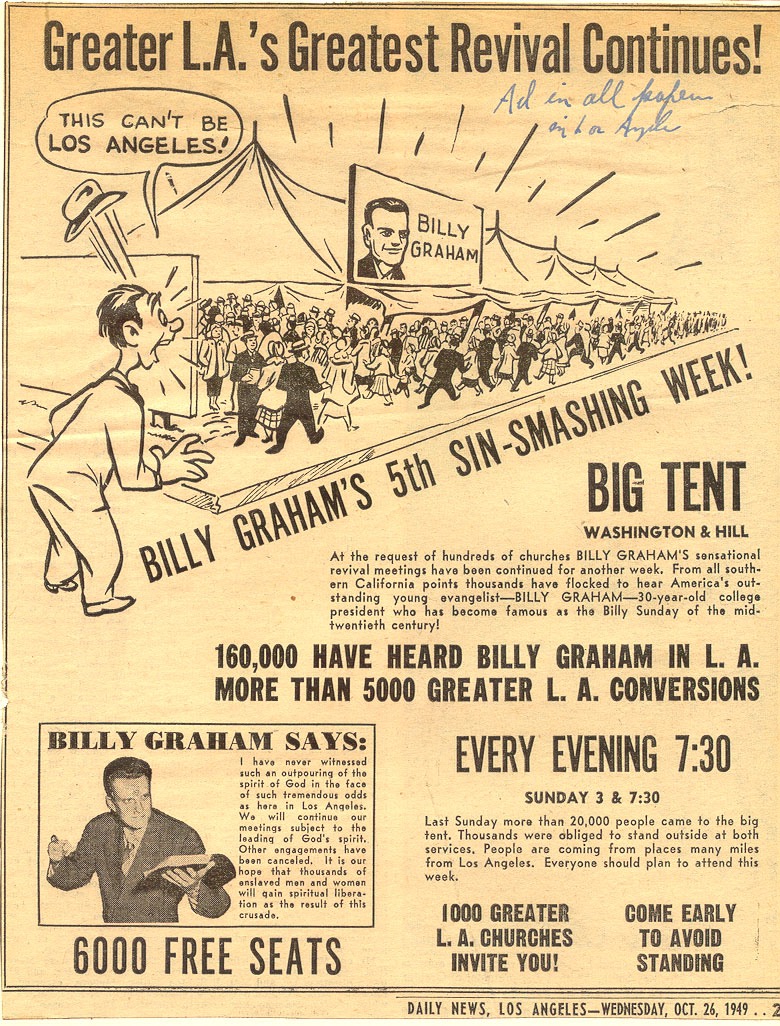Billy Graham: The Revival That Changed His Ministry
Billy Graham is widely respected as a televangelist, yet he began his traveling revivals years before the first one was televised. When Graham began traveling with his evangelistic message in the late 1940s, he was but one of a number of traveling evangelists. But that all changed in Los Angeles in 1949. What had started as a three-week revival ended eight weeks later; within two months Graham became the most prominent evangelist of his time.
In the 1940s, Graham preached in at least 17 states and 11 foreign countries (for a complete list of his revivals go here). So by the late 1940s, he was one among a number of popular evangelists. Then came the year 1949.
In that year Graham was invited to Los Angeles by a group of Christians known as "Christ for Greater Los Angeles" for a revival series. They raised financial support for Graham and his team along with renting a large tent with chairs, platform, etc. Some of this money also went to publicity, although for the first three weeks the media virtually ignored the revivals. As a matter of fact, just prior to the revivals Graham held the first press conference of his life, although almost no resultant articles came out in the papers. Three weeks later that would change.
The revival began on October 25. [A handbill is pictured below.] The attendance during those first three weeks averaged 3,000 per night, with 4,000 on Sundays. It was a size and success that Graham had anticipated. Yet something happened at the close of the three weeks which would forever change Graham’s life and ministry. This "something" centered on two men: Stuart Hamblen—a popular radio personality who hosted a daily two-hour show along the West Coast—and William Randolph Hearst—who owned several newspapers.
Hamblen came to the first revival meeting and was so convicted that he returned time and time again. During the third week, Graham and those involved with the revival considered extending it. They prayed for a sign, and it came in the form of a phone call to Graham at 4:30 in the morning: It was Hamblen. He begged to see Graham and, after coming to his room, became a Christian. With the conversion of this radio host came a tremendous amount of publicity as he promoted Graham’s revival on his popular radio show.
As for Hearst, for reasons that Graham never knew Hearst decided to prominently cover Graham in his newspapers. This led to other newspapers picking up the story of the revivals. Soon Life and Time magazines carried the stories as well as the Associated Press, which transmitted it throughout the world. As a result, Graham’s revival became so popular that it was extended five more weeks. He preached 65 sermons, hundreds of thousands attended, and 1000s became Christians.
And Graham’s ministry was changed. As he states in his autobiography, Just As I Am, "Overnight we had gone from being a little evangelistic team . . . to what appeared to many to be the hope for national and international revival. Everywhere we turned, someone wanted us to come and do for them what had been done in Los Angeles." And as we all know, Billy Graham has spent every year from 1949 to 2018 attempting to do just that.

©2004 Mark Nickens